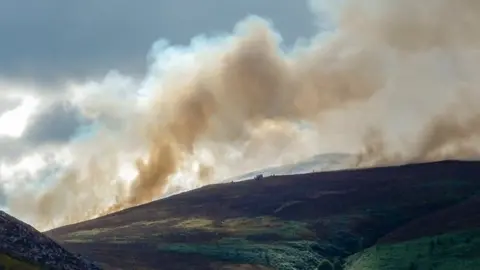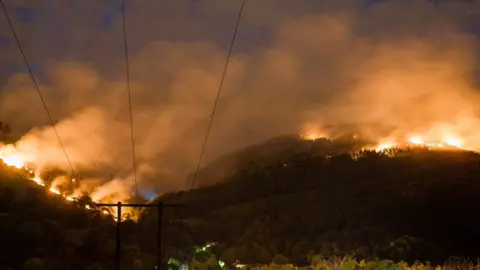Grass fires: 'Unprecedented' weather doubles call-outs
"Unprecedented and prolonged" hot weather have been blamed for the number of grass, woodland and crop fires doubling in Wales last year.
Wales' three fire authorities tackled 4,015 blazes from April 2018 to March 2019, compared with 2,090 in 2017-18.
The head of a Wales-wide fire education initiative said "unique weather" meant more people were outside, with issues including discarded barbecues.
Deliberately set blazes also rose significantly.
Newly-released Welsh Government figures shed light on challenges faced by Wales' fire and police authorities last year.
The number of arson-related fires was 2,612 in 2015-16 before Operation Dawns Glaw - aimed at reducing incidents - was set up.
 Emma Howe
Emma HoweIt is a collaboration between Wales' three fire services and four police forces.
Chairman Mydrian Harries said through engaging with communities and schools, it helped cut the numbers to 1,627 in 2017-18.
But for 2018-19, the number went back up to 2,850.
"These figures clearly show that with all the will, determination and a hugely successful collaborative task force in place, sometimes uncontrollable factors such as the weather can have a significant impact on our success," said Mr Harries.
Looking at 2018-19 compared with the year before, forces attended 230% more incidents of deliberate grass fires in June, 739% more in July, 198% more in August, 167% more in September and 114% more in October.
 Haylz87
Haylz87"When faced with unprecedented and prolonged dry and hot weather conditions, grassland and vegetation becomes susceptible to ignition and often spreads quickly to create even larger fires that present significant challenges to the fire and rescue services," he said.
"Our experience also shows that more people spend time outside during this weather, which also increases the risk of fires starting from discarded barbecues and smoking materials, for example."
While he described the figures as "disappointing", he said the weather was the "biggest contributing factor" and it did not detract from the project's work.
However, it has continued to increase its efforts to educate people and spread the message as widely as possible.
Mr Harries said: "History shows that engaging with young people through targeted interventions, high visibility patrols in vulnerable areas, and education and marketing of safety advice, works.
"Building on this, we have actively focused on the farming community to further educate and inform those responsible for carrying out controlled burns to manage land vegetation in a more controlled and safe manner."
 Rhys Bennett
Rhys BennettIn all, 70% of blazes were deliberately set, with 46% of these occurring in July 2018 - when there were nine times as many as in July 2017.
Met Office weather data showed July 2018 experienced about 40% more hours of sunshine and about half the rainfall compared with July 2017.
Incidents included 15 homes being evacuated as crews fought a mile-long mountain fire at Mynydd Cilgwyn in Carmel, near Caernarfon.
One of the biggest fires seen across Wales was at Twmbarlwn mountain, which burned for more than two weeks, while a single fire at Llantysilio in Denbighshire burned for 40 days.
More than half of the grassland fires in 2018-19 occurred in south Wales (52%), 32% were in mid and west Wales, and 16% were in north Wales.
There were two non-fatal casualties - the last fatality resulting from a grassland fire was in 2007-08.
